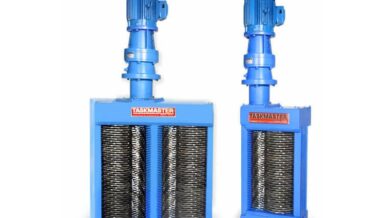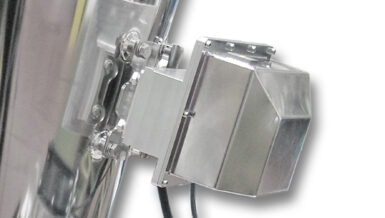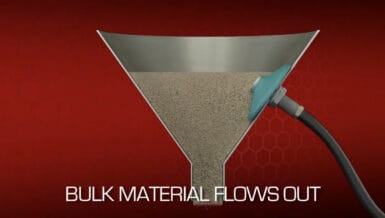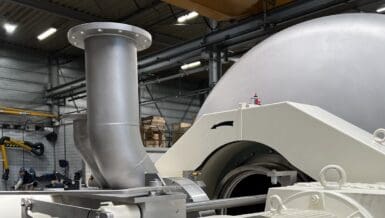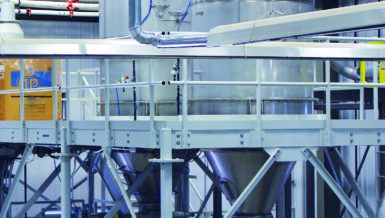Understanding the flow behavior of granular bulk solids is essential to troubleshooting issues with processing equipment. Subtle changes in how your material flows may drastically affect the overall performance and operability of the equipment.
Moving bed heat exchangers (MBHE) that use a vertical plate or vertical tube technology to transfer heat to or from a product are no exception to this phenomenon. To ensure uniform heating, cooling or drying, it is desirable for each particle of material entering these units to have a similar residence time (e.g., total time spent in the equipment).
To achieve uniform residence times, vertical plate heat exchangers are designed with discharge feeders that provide uniform mass flow. Yet whether due to wear on equipment, changes in characteristics of the granular solids (e.g., moisture content, particle size, and shape, the inclusion of foreign material) or changes to processes (e.g., flow rate), the flow behavior within these MBHEs can change from uniform mass flow to just mass flow, funnel flow or even no flow (plugged).
By understanding the differences between these conditions, you can quickly find the root cause of the issue and get your heat exchanger back to peak performance.
No flow
A no-flow or plugged condition is often the easiest to identify. Whether due to mechanical bridging, the cohesive properties of a material, or caking, the bulk solid material may begin to build up in the heat exchanger. These plugs tend to extend throughout equipment over time, and may eventually lead to a full blockage of the equipment.
As the plugging extends through the equipment, the product flows more quickly through the remaining unplugged areas, resulting in a loss of residence time and, therefore, a substantial loss in heat transfer performance. If the cause of the plugging is not addressed, the equipment may become fully plugged and no material will be able to be discharged from the equipment.
Funnel flow
Funnel flow typically occurs in equipment that utilizes a poorly designed transition hopper to decrease the footprint area above a discharge device, as would be the case in a conical hopper above a rotary valve.
In a funnel flow pattern, a relatively small area of the equipment will see a flowing product while the remainder of the product remains stationary. The stationary product may discharge when the equipment is fully emptied, but you will typically see diminished, but stable, equipment performance similar to what may occur in a partially plugged situation.
Mass flow
When discussing granular bulk solids, mass flow is a condition where all particles within the equipment are in motion at the same time. This is an ideal condition for silos as it ensures the product is discharged from a silo in roughly the same order that it is introduced (e.g., first in, first out).
Utilizing mass flow behavior also changes how equipment is designed by allowing for more predictable calculations of stresses and reduced chances of shock loads from sudden shifts in product flow that can occur in a funnel flow situation.
MBHEs operating in a mass flow condition will typically perform well, but there may be inconsistencies within the discharged solids – for example, slight temperature gradients or differences in moisture content at different points across the product discharge stream.
Uniform mass flow
When operating in a uniform mass flow condition, not only are all the particles in a piece of equipment moving at the same time, as is the case in mass flow, but they are also moving at the same velocity. This is a critical distinction as it ensures each particle spends the same amount of time in the process equipment as for every other particle, leading to exceptional uniformity of product at the discharge point.
How to identify flow behavior patterns
You can directly observe the flow behavior in a vertical plate heat exchanger by opening the inlet hopper inspection hatches and watching the product bed as the unit is emptied. The surface profile of the bulk solids should remain unchanged while the level decreases in the unit.
In addition to direct observation, indirect identification of the flow pattern can be accomplished by marking a horizontal line around the exterior of the heat exchanger and measuring the temperature at different points along this line. The temperature measurements along this line can be used to identify different flow patterns as follows:
Identifying uniform mass flow
If the temperature along a horizontal line on your heat exchanger is uniform, your unit is very likely operating with the uniform mass flow. This is a good sign!
Identifying mass flow
If the temperatures at different points along a horizontal line around the heat exchanger are inconsistent but do not reach the temperature of the heat exchange fluid, you are likely encountering a non-uniform mass flow situation. In this case, there is often no immediate action required so long as your process is stable.
At your next routine shut-down, take extra care to inspect the surfaces of any transition cones and the discharge device itself for damage, caked product, or wear which could be causing flow inconsistencies.
Identifying funnel flow and no flow
If the temperatures at different points along a horizontal line around the exchanger are inconsistent and approach the temperature of the heat exchange fluid, there are likely areas where the product is not flowing or flowing extremely slowly. This type of situation should be monitored closely, especially if the bulk solid being processed is subject to degradation, spoilage, or overheating that can lead to fires (e.g., oil seeds conditioning).
In these situations, take the heat exchanger offline for maintenance and inspect it to determine the cause of the poor flow condition prior to cleaning and restarting.
If upon emptying the unit for inspection, there is little or no product left in the areas where inconsistent temperatures were noted, there is likely a funnel flow condition. In this case, the discharge device and any transitions may need to be examined more closely.
If there is product still in the plate bank even after the unit has been run ‘empty,’ there may be caking, mechanical bridging or excess debris to be dealt with before the equipment can be successfully operated.







